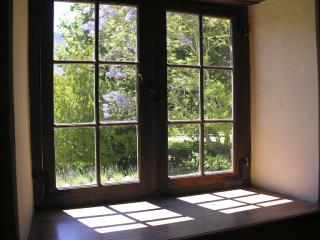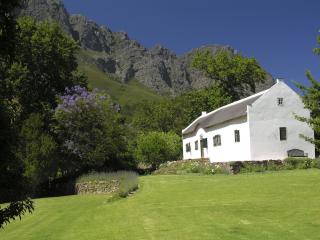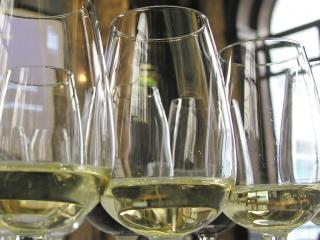Reflections on a Chardonnay
POSTED ON 27/07/2009I had bought a case of the 1997 Chamonix Chardonnay from Franschhoek after coming across it at a Decanter Magazine tasting of South African chardonnays when I had been impressed by its relatively austere, dry character, which I thought resembled a good white burgundy. And the case served me very well, so when I found this bottle lurking at the back of the cellar, I thought I’d give it a try. It was just starting to oxidise now, still dry, still drinkable but just a little too rancid butter to be enjoyable.
 a window on Franschhoek
a window on Franschhoek
Cape Chamonix is made by the extrordinarily youthful-looking Gottfried Mocke in the pretty Cape town of Franschhoek, aka French corner because of the migration of the French Huguenots to the area. The estate itself was originally part of the first farm, La Cotte, granted to the Huguenots in 1688, of 290 hectares. I like their wines a lot, the 2007 chardonnay and pinot noir reserves showing terrific elegance and finesse, and available through their agent in the UK, Richards Walford.
A friend said he thought the Cape Chamonix Chardonnay would be better than a Hamilton Russell Chardonnay, and though I didn’t have a 1997, I did happen to have a mature bottle of the Hamilton Russell Chardonnay which an ex-neighbour had given me. I dusted it down and it turned out to be the 2000 Hamilton Russell Chardonnay so I opened it and wow! It was quite superb, beautifully evolved on the nose with lovely farm butter richness and similarly on the palate, a lovely rich Meursault-like dry white with such richness that it was almost honeyed, but the evolution had rendered it deliciously nutty and dry.
 Cape Dutch in Franschhoek
Cape Dutch in Franschhoek
I have a lot of time for Hamilton Russell. Based in the Hemel-en-Aarde (Heaven on Earth) Valley in Walker Bay. The company was started by the engaging Tim Hamilton Russell, who pioneered burgundian styles as well as championing workers' rights in the apartheid era long before South Africa's empowerment projects got off the ground. Today the estate is run by his son Anthony, who continues the tradition of making one of South Africa's best chardonnays and pinot noirs. The olive oil and honey are pretty good too.
I didn’t finish the bottle that evening, but there was some left in the bottle and when I came back to it two days later after leaving it in the fridge, it was still delicious, I had another glass and used the rest for the asparagus risotto I was making. Useful tip: always use the leftovers of a good wine if you need some wine for cooking rather than a glass of something cheap and basic.
 make mine a chardy
make mine a chardy
Talking of chardonnay, I was sent a bottle of 2007 Chateau de Gaure, Limoux by a good friend, Christine Ontivéro, who lives in Perpignan, wears brilliant Catalan hats, has a wine writing partner called Michel Smith and a son called Victor. Christine knows everything about the Languedoc-Roussillon that you could possibly want to know, and more.
This wine is simply gorgeous, a Limoux chardonnay, so Atlantic-influenced and excellent in its natural acidity; add to that a smoky aroma, a richness and lovely oatmealy lees-stirred quality and peachy-rich fruitiness with a lemon-curdy acidity and mineral dry finish, and it all adds up to a very superior southern French chardonnay indeed. Taste this blind and you might think yourself somewhere not a million miles from Meursault, but it has an almost New World zip and opulence that makes it even better than many a Meursault. Magic. So, Christine, please let us know where can we buy this?

